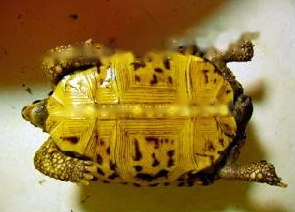Tortoises are the favorite of many tortoise lovers. Many tortoise friends hope to raise a tortoise to accompany them to old age. However, according to some protection policies in my country, most of the tortoises belong to the national first- and second-level protected animals. So, fellow turtle friends, don't try to challenge that red line. If you violate the laws and regulations because of your hobbies, it will be a bit of a loss.
Of course, we can't raise them at home, but that doesn't mean we can't understand and appreciate tortoises. Today, I will take you to learn about the flat-tailed tortoises, and let's popularize their knowledge together~

1. Species Introduction
The flat-tailed tortoise is a species of tortoise distributed on the west coast of Madagascar. They are very similar to spider web tortoises in appearance and living habits. Some call them subspecies, but after in-depth research by biologists, the flat-tailed tortoise has been identified as a single species of tortoise.
Second, Morphological Characteristics
The body length of the flat-tailed tortoise is generally about 12-15cm after adulthood. Their carapace is very flat (it should feel good--!), and there are some sharp zigzag protrusions on the back edge of the carapace (don't know why defensive weapons have long backs...).
Normally the color of the deck will be black as a child, and as it matures, the color will change from black to light brown, with some yellow spots on the edges. The plastron is colored with brown spots.
The color of the head is generally yellow with black spots, and occasionally there are other different colors, and the gap between different individuals is still very large. The upper and lower jaws of the beak are yellow, and the limbs are light brown in color.
The point is, their tails are different from other tortoises, they are flat, like a shovel, hence the name Flat-tailed tortoises.

3. Living habits
The flat-tailed tortoise lives in the drier deciduous forest. When the rainy season comes, their activities will become more frequent. They will sleep in dead trees or piles of leaves. Their main food is to eat the leaves, stems and fruits of rotten plants.
Where the flat-tailed tortoise inhabits, the temperature difference between day and night will be very large, generally 14-32 ℃, and the humidity will be about 70%. In the cold season, the nighttime temperature will be lower than 10 degrees (compared to tropical areas, this temperature is already very low, don't take our domestic temperature changes as a reference~), they especially like to be in such low temperature The next activity, will not go to hibernate because the temperature is low.

IV. Population status
The population of flat-tailed tortoises has begun to decrease sharply due to habitat destruction and overcapture by people. In 2000, the flat-tailed tortoise was still exported to various countries in the number of several hundred each year. In order to protect this species, in 2002, the Convention on International Trade in Endangered Species of Wild Fauna and Flora included the flat-tailed tortoise in Appendix I, prohibiting the trade of this tortoise species to avoid further decline in numbers.
Finally, what the author wants to tell you is that there are many scammers selling tortoises on the Internet. Call the police, after all, buying and selling are illegal, and in the end, I can only be dumb to eat Huanglian and I can't tell!
![[Original] Sharing of popular science knowledge of ringed map turtles](/static/img/11249/11249_1.jpg)






